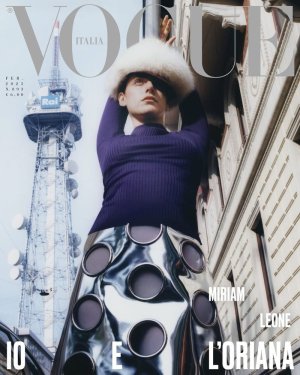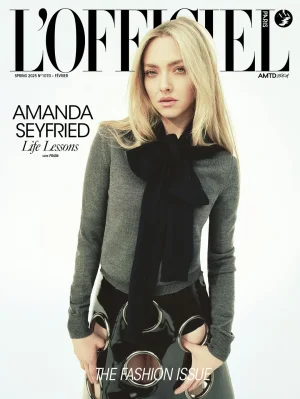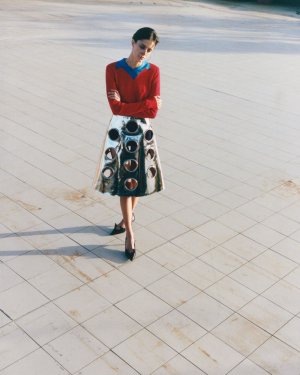MILAN FASHION WEEK SEPT. 20, 2024
Prada Pushes Fashion Forward With Its Collection
“Every look was made on a person,” Raf Simons said of the collection created alongside Miuccia Prada.
By Cathy Horyn, the Cut’s fashion critic-at-large since 2015.
Prada’s new collection goes everywhere: It’s kinky; it’s prim; it goes to the past and then yanks you back to the present. But anyone who follows fashion knows by now that. My neck got sore watching yesterday’s show because whenever a model came whipping around a bend in the maze-y runway, the person’s style expressed a uniquely different attitude, often taking in neutral gender. You almost couldn’t keep up with the changes. But the reason that people know what Miuccia Prada and Raf Simons did in Milan — the reason the applause was thunderous — is the reason the brand is consistently high on the Lyst Index, which measures popularity based on shopping and internet traffic.
Creatively, Simons and Prada go further than most designers.
Information — the sheer volume of images and ideas that sets apart our age — is the subject of their latest work. The designers considered how algorithms direct our choices then framed the show, Prada said, as “a dialogue” with this reality rather than a critique.
“I was very, very nervous for this show, much more than usual,” Prada told reporters afterward. From the start of her fashion career, in the late ’80s, when she made some clothes for her family’s leather-goods firm, Prada declared her own terms. In the ’90s, she felt free to switch up the house’s style from one season to the next, in contrast to the standard practice of maintaining a consistent image.
Prada meant disruption before that term was in vogue.
But this latest change is significant. Like other designers, Prada always presented clothes in thematic groupings, often showing many variations of a style for emphasis, and she continued to do that when Simons became her co–creative director. Near the end of the pandemic, they made a collection of satin miniskirts with the couture touch of trains. And they showed you a lot of them. Later, they did the same with leather jackets, presenting multiple versions. By doing that, they effectively
owned the look, and of course, that’s partly how they recharged Prada, raising its sales in the process. Like most designers, they also tended to show a concise edit of shoes and accessories on the runway.
Well, they broke up that practice on Thursday. There were 49 models in the show and, as best as I could tell, 49 different styles of shoes and almost as many choices of bags.
“Every look was made on a person,” Simons said. The individuality of the looks relates to the haute-couture tradition, where everything is made for an individual’s body, and Prada and Simon slyly referenced couture with seating cubes draped in aqua satin and with a few embellished dresses, including one with glossy black feathers and worn with a loose, orange windbreaker.
But that’s as far as the couture connection went. This was ready-to-wear with a huge dose of sportswear, including stretch pants with clingy polo shirts and a red cotton bomber jacket with tailored pants. Those seemingly conservative styles were juxtaposed with vintage-looking pieces, notably porthole skirts and visor-brim hats that recalled the ’60s. In between was a fetish-looking black leather shift embellished with silver rings, low-riding skirts with metal links fastened to a leather belt, and sedate town coats in a leopard pattern or tweeds with fake-fur collars. It sometimes felt like the Tenenbaums had taken up residence at the Prada Foundation.
The show was exhilarating to watch, partly because you quickly realized you couldn’t predict what was coming next around the curves of the runway. Which is like the sensation of being bombarded with information online, or walking in the street of a large city. Simons and Prada said they liked the idea of people projecting themselves in their style as “superheroes” — the extreme-looking sunglasses helped make that point — and that, as Simons said, the message was “about your own authority, your own personal strength.”
That authority once belonged mainly to designers. Indeed, in the mid-19th century, dress designers became an all-powerful force because of their new artistic authority. Marketing and branding quickly followed, sealing the loyalty between women and fashion houses (and magazines). That relationship has changed dramatically in this century.
It was great to see Prada and Simons not only address those cultural changes but also break out of their own patterns.
Will they continue in this vein? Probably not, but I think this show gave them an opening to other possibilities. Did the extreme mix of styles add to the information overload? I think not. The designers and their team, which includes those who do styling and casting, firmly guided the aesthetics and added looks that may actually reach a wider audience. Above all, the show reflected the reality and speed of this moment. I should also note that Prada is able to take such a leap forward because it has the industrial capability, the side of the business long managed by Miuccia Prada’s husband, Patrizio Bertelli. But the point is they put both sides, creative and production, to maximum use.




